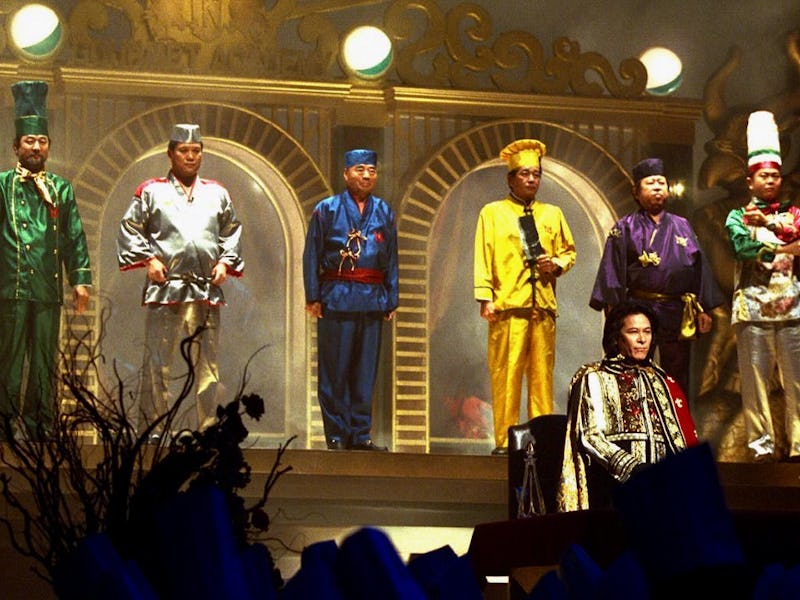When Iron Chef premiered in Japan on October 10, 1993, the show was an instant hit, taking cooking competitions to new heights by pitting gladiator chefs against challengers in a Colosseum-style kitchen. Nobody realized then, but Japan turned cooking into a blood sport.
Before Iron Chef arrived, cooking shows were — and still mostly are — centered around the cults of celebrity chefs. These famous culinary experts appear on TV screens to demonstrate recipes that viewers could themselves follow along and cook at home. Julia Childs and her successors paved the way for easy-breezy, daytime television specials that were cheap to produce and popular with the domestic crowd. Iron Chef took the established formula of chefs on TV and turned it into something new and exciting.
Kitchen Stadium
Each episode of Iron Chef began with Chairman Kaga, the royally dressed overseer of Kitchen Stadium. He would open the stage by telling the audience of his dream for a grand cooking competition before introducing to the stadium the challenging chef who would face head-to-head against one of his Iron Chefs. The “story” was that Chairman Kaga, himself a gourmand, dreamed of food in a way never before imagined. So he constructed Kitchen Stadium and retained three Iron Chefs who would hone their craft and defend their honor against chefs from all over the world.
Iron Chef became the base model for most future reality cooking competitions. Shows like Top Chef, Chopped, and Cutthroat Kitchen all owe a debt to Iron Chef for introducing the notion that watching chefs compete against one another could not only be entertaining, but brutal. One look at Food Network mainstay Alton Brown’s face as he offers the devil’s deal of replacing one contestants cutlery with plastic utensils on Cutthroat Kitchen is all anyone needs to see that cooking competitions are no joke.
The cooking competition revolution wasn’t just limited to television networks either. While Japanese manga has a long history of cooking-related manga that predate Iron Chef, it was only after the show premiered that cooking-based combat manga started emerging in such exaggerated forms. One manga, Toriko — written and illustrated by Mitsutoshi Shimabukuro — stars a “Gourmet Hunter” who travels the world for exotic new recipes while engaging in Dragon Ball style combat with enemy chefs.
Another manga, localized in the United States as Food Wars!: Shokugeki no Soma, stars students at an elite culinary high school as they face-off in Iron Chef-style cook-offs against other top-ranked student chefs. Food Wars! is one of the most popular series in both the United States and Japan and the 12th most read manga for males in Japan for 2014. The combination of gorgeously illustrated food, intense kitchen-based combat, and gratuitous, sexually-charged reactions from the judges eating the food made the manga an instant hit among Japan’s male readers. Suddenly, cooking became a martial art within pop culture.
Food Wars!: Shokugeki no Soma
It wasn’t long before this cultural evolution perception would follow Iron Chef into global consciousness. Tom Eastman and the rest of the Trinket Studios team have been hard at work on their biggest video game project: Battle Chef Brigade. Battle Chef is an action game very much influenced by Iron Chef and anime. “The initial spark for Battle Chef Brigade was the Food Network, which we had turned on during lunch after a morning of fruitless brainstorming,” Eastman told Inverse.
Eastman said he and the team don’t read any cooking manga or watch cooking anime for fear of cross-contamination. Trinket Studios is aware of their game’s appeal with combat-cooking enthusiasts. “Our fans love to mention their favorite [anime] though, which helps us confirm Battle Chef Brigade is something that should exist!”
Battle Chef Brigade
That crossover appeal of violence, beauty, and sex is the DNA makeup that cooking competitions share with professional wrestling. Iron Chef smartly utilized a few of wrestling’s formulas, such as introducing Iron Chefs with backstories and unique personalities while at the same time inciting competitive rivalries.
In 2000, American superstar chef Bobby Flay made his first appearance on Iron Chef, competing against Japanese chef Masaharu Morimoto. Flay would finish the match standing on top of his kitchen setup with his foot over the cutting board — a move Chef Morimoto found disgraceful, decrying Flay as “not a chef.” The most famous culinary rivalry was born.
Surprisingly, Food Network’s website lists Iron Chef as having raised the status of Japanese cooks, who until then were poorly regarded in society. This seems surprising to read today considering Washoku (和食), or Japanese Cuisine, is revered in a way few other Asian cuisines are. Since 2011, Japan has overtaken France for having the most Michelin stars, a prestigious award given to the most exceptional restaurants. The Japanese have pride in their cuisine,and its perception and status abroad. Why else would Iron Chef highlight its contest as a fight between Japanese cuisine and the rest of the world?
Cooking networks have tried to imitate the success of Iron Chef by first introducing a domestic spin-off, Iron Chef America, before producing a few homegrown originals. Cutthroat Kitchen introduces a capitalist twist by allowing chefs to purchase contest rule modifiers like the barring of opponents from using certain ingredients. Chopped emphasizes on-the-spot improvisation by revealing secret ingredients. Top Chef combines the celebrity chef allure with high society by creating a luxury cooking competition reality show.
Alton Brown, host of Cutthroat Kitchen
However, none of these come close to replicating the absurd heights of the original Iron Chef. While Iron Chef America modernized Kitchen Stadium and upped the celebrity factor, what remains is the royal pageantry, the appropriately oversized drama of Kitchen Stadium, and the immortal words of Iron Chef’s Chairman Kaga: “Allez cuisine!”
